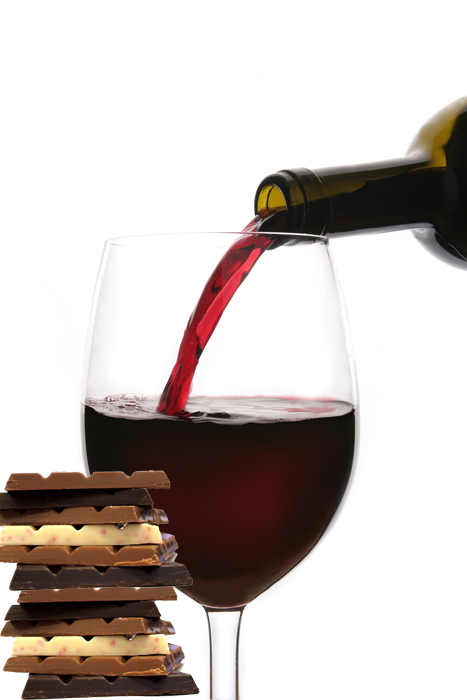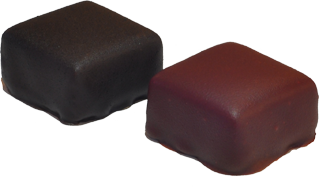 " Chocolate origins are savoury, not sweet."
" Chocolate origins are savoury, not sweet."
Ancient Aztecs, incorporated the beans into water mixed it with chilli and cinnamon as a drink. Or made a cornmeal gruel
chocoholics might forgo the gruel; but more of us are coming around to the idea of savoury chocolate.
"People are now interested in getting chocolate in all parts of their diets -- not just dessert,"
Imagine the lights are low there’s a fire in the hearth. The mood is set for a perfect romantic meal You have a special treat ready to make tonight’s meal special. Tart au chocolat made with 70% dark Chocolate, But what about the drink Merlot?
The chocolate flan is perfect with its rich intense taste and velvety smooth texture. You reach for your wine glass and take a sip.
Your mouth dries out instantly. It's almost insulting to the chocolate and wine to have paired them so badly.
What otherwise would've been a very good Merlot, now tastes as though you've been sucking on an old rubber band your guest will always blame your wine choice never the chocolate.
Just as with wine, chocolate is influence by the Terroir so it presents us with a complexity of flavours and textures, with the potential for subtle changes with each batch of chocolate.
Learning how to appreciate the subtlety and complexity of flavours that both wine and chocolate have, as well as being able to pair them well, is a real labour of love
Some chocolate companies’ guidelines suggest that a 55% dark chocolate will go with every cabernet sauvignon, and a 56% dark chocolate will go with any pinot noir, but whose 55% dark chocolate? And which actual wine? make sure you test first (it can be fun)
Which wine goes well with chocolate some foodies say don’t mix I disagree if its done thoughtfully it can work just follow these tips?
 Tips for Pairings Wines with Chocolate
Tips for Pairings Wines with Chocolate
The wine should be as sweet, if not a bit sweeter, than the chocolate you are eating. Otherwise, the taste may veer towards sour.
This may sound obvious but I’m going to say it, match lighter, more elegant flavoured chocolates with lighter-bodied wines;
The stronger the chocolate, the more full-bodied the wine should be.
For example, a dark chocolate tends to pair well with a bold, California Zinfandel.
The key to pairing any red wine with chocolate is fruit, not tannin. You should find very obvious dark fruit flavours and resolved (certainly not bitter) tannins. Tannic acid and chocolate are opposed
When we are pairing wines with chocolate, it’s best to match lighter, more elegant flavoured chocolates with lighter-bodied wines; likewise, the stronger the chocolate, the more full-bodied the wine should be.
For example, dark chocolate tends to pair well with an intense, in-your-face California Zinfandel or even a tannin-driven Cabernet Sauvignon.
The darker the chocolate the more tannins it will display.
However, when you pair this darker chocolate up with a wine that has stout tannins, the chocolate will often overshadow or cancel out the wine's tannins on the palate and allow more fruit to show through.
Like “formal” wine tasting, if you tasting several varieties of chocolates, work from light to dark.
White wines have a light body which go very well with milk chocolate; but watch out, most are too dry to be paired.
But there are some truly amazing combinations like Chardonnay paired with Vanilla Dessert like panna cotta.
wines don't really stick to any "rules" about wine and chocolate pairings.
Champagnes go well with almost any type of chocolate even white, while Port and Sherry are best suited to dark chocolate.
How to taste wine and chocolate together
In order to taste chocolate and wine together we need to first remember our sensory analysis for both items.
But we have two problems with this:
One: chocolate and water doesn’t mix the chocolate seizes and the texture becomes chunky and cold liquid also affects the texture of chocolate negatively.
Two: wines should be served at the ideal temperature which especially for whites is too cold to make pairing them with chocolate easy the cold makes our taste buds contract.
In order to taste chocolate and wine together enjoyably these problems have to be solved.
To do this, place a piece of chocolate in your mouth and chew it until it has melted completely, working the chocolate with your tongue to incorporate some saliva from your mouth. The idea is to mix in enough warm liquid so that adding cold liquid -wine won't be such a shock to the chocolate and cause it to seize.
When the chocolate has a thin consistency, take a sip of wine- about the same amount of wine is the amount of chocolate in your mouth.
Mix the wine and the chocolate together in your mouth by gently swishing, paying attention to the taste and texture sensations in your mouth before swallowing the wine and the chocolate.
Wait at least 10 seconds after swallowing the chocolate and wine before taking a small sip of wine to rinse any leftover chocolate from your mouth.
Despite the affinity for one another, many wine and chocolate pairings fight for the same ‘palate space’ making the whole experience unpleasant.
Fortunately for you, there are wine and chocolate pairings that work here are some of my best suggestions.
Dark Chocolate
Dark chocolates need a wine that has a roasted, slightly robust flavours itself, with perhaps a hint of its own chocolate notes.
Some dark chocolate can have Slight notes of tobacco, fruity, earthy, and oaky, red berries, salt, smoke. Cabernet Sauvignon and Zinfandel are past masters of perfecting the dark chocolate and wine match.
Dark Chocolate Wine Suggestions
Beaujolais, Bordeaux, Cabernet Sauvignon, Cognac/Armagnac, Grenache, Malbec, Marsala, Merlot, Orange Muscat, Tawny Port, Ruby Port, Shiraz, Zinfandel
Because of the intensity of flavours, dark chocolates need to be paired with stronger red wines with concentrated fruit notes.
While some of the wines above can appear too tannic to pair with chocolate, the cocoa
butter reduces the acidity and dryness of the tannins enabling the higher cacao content chocolate to pair well.
Fortified wines like Ruby Port have chocolate in the nose, as well as red berries, and are great companions to chocolate.
Tawny Ports, which have nutty and tobacco/leather notes, also make good pairings.
Vintage Ports: Be careful their high sugar and alcohol content can overwhelm the chocolate.
Beaujolais and Orange Muscat bring out fruity notes. While Orange Muscat, a dessert wine, is a obvious choice, Beaujolais is unusual. If you like the wine, try it.
Cabernet Sauvignon (including Bordeaux) brings out the fruity-peppery-grapy notes in the chocolate.
Muscat complements dark chocolates with fruit fillings, or fruit-flavoured truffles, bringing out the fruit notes.
Spicy Zinfandel brings out chocolate’s spicy nuances.
Milk Chocolate
Milk chocolate is sweeter and has a lower percentage of chocolate liquor.
This, along with its milk content, yields a milder, sweeter product with fewer flavours and aromas.
Prominent flavours include brown sugar, cocoa, vanilla, honey, caramel, milk, cream,
nutty and/or malt. Pinot noir or a lighter-bodied Merlot will complement a bar of milk chocolate, a creamy chocolate mousse or chocolate cheesecake.
Pinot Noir or a lighter-bodied will complement a bar of milk chocolate, a creamy chocolate mousse or chocolate cheesecake. Rieslings, and dessert wines pair well with milk chocolates. Also, a sparkling wine or Champagne for pairing with milk chocolate dipped strawberries.
Last, but not least a classic milk chocolate pairing to consider is a nice Ruby Port
Whiskey works well with oaky notes working together well.
Milk Chocolate Wine Suggestions
Hungarian Tokaji, Mas Amiel Rouge & Vintage Blanc, Muscat/Moscato, Tawny Port
Sweeter chocolate needs sweeter wine,
Hungarian Tokaji works great with milk chocolate ganache.
Muscat, a white dessert wine with peach and apricot flavours, is also a popular partner for milk chocolate.
Tawny Port, a fortified wine, is the strongest match with milk chocolate. Its nutty nuances highlight milk chocolate’s nutty and caramel notes and builds the overall chocolate flavour
White Chocolate
Made without chocolate liquor and thus not a true chocolate, white chocolate is a rich product made with cocoa butter, sugar and milk solids. It has sweet flavour notes including cream, Butter, milk, honey, vanilla, caramel, and/or fruit. White chocolate tends to be more mellow and buttery in flavour, making it ideal for Sherry which will pick up the creaminess of the chocolates.
Sherry, Moscato d'Asti, or Orange Muscat the Sherry and Moscato d’Asti will pick up the creaminess of the chocolates and the Orange Muscat will pick up any fruit tones on the scene.
Another route, for pairing wine with white chocolate is going for the contrast pairing approach,
White Chocolate Wine Suggestions
Champagne, Gewurztraminer, Mas Amiel Vintage Blanc, Muscat/Moscato, Riesling
While to some the concept of Champagne or other sparkling wine with chocolate is romantic, the acid in sparkling wines produce tart flavours when paired with the cacao in milk or dark chocolate. However, there is no cacao in white chocolate, so white is a fine choice. Fresh strawberries dipped in white chocolate are very romantic! Even then, don’t crack open a great bottle which is vinified to be dry for food. Get a sweeter Champagne: a sec or a demi-sec.
Gewurtztraminer has a slight sweetness plus typical lychee fruit. Along with Riesling (see below), an exotic pairing with white chocolate’s typical dairy and caramel flavours.
Mas Amiel, a sweet wine from Southwest France, were born, to match with chocolate; and their Vintage Blanc specifically with white chocolate.
Muscat, also pairs well with white chocolate, bringing out any fruit notes within. It may pair better than other white dessert wines because it is less acidic.
Riesling has an exotic sweet-ness that complements the vanilla, caramel and honey flavours of white chocolate.
